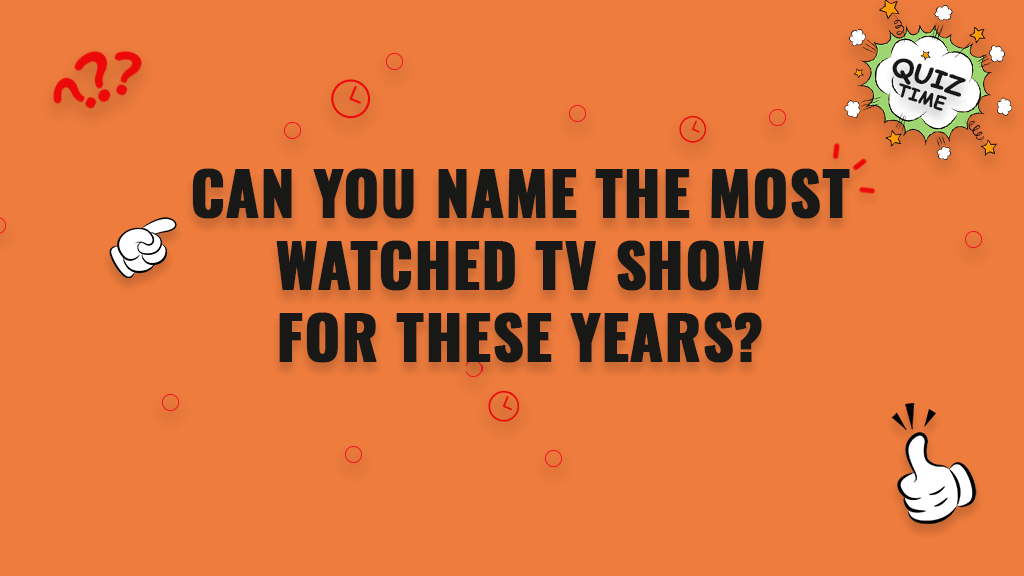❤️It's Trivia, but Sweeter❤️
Can You Name the Most Watched TV Show for These Years?

Television shows have always been a significant part of popular culture, reflecting the societal trends, interests, and issues of their time. Since the early days of broadcast TV, the most-watched shows have often defined the era in which they aired. From family sitcoms to reality television, each decade has brought with it a unique lineup of TV programs that captured the attention of millions of viewers. Understanding which shows dominated the ratings in various years offers a fascinating glimpse into what people were watching, what entertained them, and how television evolved over time.
Television ratings are a critical aspect of the entertainment industry, as they provide networks with valuable insights into the preferences of their audience. The Nielsen ratings system has long been the standard for determining the popularity of TV shows, measuring the viewership of programs through a representative sample of households. These ratings are used not only to gauge the success of a show but also to influence decisions about renewals, scheduling, and advertising. A show that consistently draws large audiences can become a cultural touchstone, and many of the most-watched TV shows have become iconic due to their immense popularity.
In the early days of television, sitcoms and variety shows were the dominant genre. Shows like “I Love Lucy” in the 1950s and “The Ed Sullivan Show” in the 1960s were watched by millions of people each week. These programs were groundbreaking for their time, often offering humor and entertainment that reached a wide audience. “I Love Lucy,” for example, was a revolutionary sitcom that changed the landscape of television comedy, making Lucille Ball a household name. As television technology improved and cable networks expanded, the variety of available programming grew, allowing for more specialized content that could cater to different interests and demographics.
By the 1980s, television had become a more segmented and diverse medium, with prime-time shows attracting massive audiences. This was the era of the “watercooler” TV moment, where the most-watched shows generated nationwide conversations. In 1985, for example, “The A-Team” was the top-rated show in the U.S., a fast-paced action series that captured the imagination of viewers. That year also saw the rise of “Family Ties” and “The Cosby Show,” two family-centered sitcoms that provided an escape from the chaotic political and social landscape of the time. These shows were not only entertaining but also often included social commentary on family dynamics and personal values.
As the 1990s rolled in, television audiences were captivated by a new wave of sitcoms and dramas that explored the complexities of everyday life. In 1990, “The Cosby Show” claimed the top spot in the ratings, solidifying its place as one of the most influential TV series in history. Bill Cosby’s portrayal of Dr. Heathcliff Huxtable, a successful and loving father, resonated with millions of viewers, especially those seeking positive depictions of African American families. Similarly, “Seinfeld,” which topped the ratings in 1995, became a cultural phenomenon. Often described as “a show about nothing,” “Seinfeld” revolutionized television comedy with its unique observational humor, and it remains one of the most beloved sitcoms to this day.
The 2000s marked the beginning of the era of reality TV, with shows like “Survivor” and “American Idol” dominating the ratings. In 2001, “Friends” was the top-rated show, a sitcom that chronicled the lives and relationships of a group of six friends living in New York City. Its blend of humor, heart, and relatable characters made it a cultural juggernaut, and its success helped redefine what a “must-watch” TV show could be. At the same time, reality TV started to make its mark, offering unscripted drama and competition that kept audiences on the edge of their seats. “Survivor,” which debuted in 2000, became a breakout success, bringing a fresh and exciting format to the small screen that would change television programming forever.
In 2008, reality television continued its reign with shows like “American Idol” leading the ratings. The singing competition brought the American dream of stardom to life, providing contestants with a platform to showcase their talents and allowing viewers to vote for their favorite performers. This interactive format kept audiences engaged season after season. During this time, other scripted shows, such as “Grey’s Anatomy” and “NCIS,” also gained immense popularity, proving that audiences still had an appetite for character-driven drama. “NCIS,” in particular, became one of the most-watched shows of the 2010s, solidifying its place as a long-running success.
The 2010s saw a shift in the way people consumed television, with streaming services like Netflix, Hulu, and Amazon Prime Video giving viewers more control over when and how they watched shows. While traditional television still had its share of blockbuster hits, the rise of on-demand streaming altered the landscape of television consumption. In 2015, “The Big Bang Theory” emerged as the top-rated show, a sitcom that appealed to both geeks and mainstream audiences alike. Its humor, centered around a group of socially awkward scientists and their interactions with the world around them, struck a chord with millions. At the same time, the streaming revolution began to take hold, with Netflix producing original programming like “Stranger Things” and “The Crown” that drew huge audiences and became cultural touchstones in their own right.
The way people watch television has changed dramatically over the last few decades. While traditional TV shows dominated the ratings for much of the 20th century, the rise of cable networks and streaming services has fragmented the audience. The influence of shows like “Game of Thrones,” which became a global phenomenon during its run, is undeniable. This fantasy epic, based on George R.R. Martin’s book series, captivated millions with its complex characters and intricate plotlines. It became the most-watched show for its network, HBO, during its run, and its influence has extended far beyond the realm of television into pop culture at large.
While ratings and audience numbers are still important, the experience of watching TV is now much more personalized. With the advent of DVR, streaming services, and on-demand programming, viewers no longer have to adhere to rigid broadcast schedules. This shift has led to an increase in binge-watching, where entire seasons of shows are consumed in one sitting, allowing for a different kind of viewing experience. This change in behavior has also altered the structure of TV shows, with many series now designed for binge-watching rather than episodic storytelling.
Despite these changes, the impact of television on society remains profound. The shows that have dominated the ratings over the years reflect the values, interests, and concerns of each generation. From family-friendly sitcoms to gritty dramas and reality competitions, television continues to be a window into the world, offering both escapism and insight. The shows that rise to the top of the ratings not only entertain but often spark conversations about social issues, personal identity, and cultural norms. As the TV landscape continues to evolve, one thing is clear: the power of storytelling and its ability to unite audiences remains as strong as ever.
In conclusion, the most-watched TV shows across different years provide a fascinating look at the changing tastes and interests of society. These shows reflect the evolving nature of television, from the days of broadcast networks to the rise of streaming services. Whether it’s a sitcom, drama, reality show, or fantasy epic, TV has continued to captivate audiences and shape popular culture, influencing how we see the world and each other. Understanding these shifts not only reveals the history of television but also offers a deeper understanding of how media continues to impact our lives.



